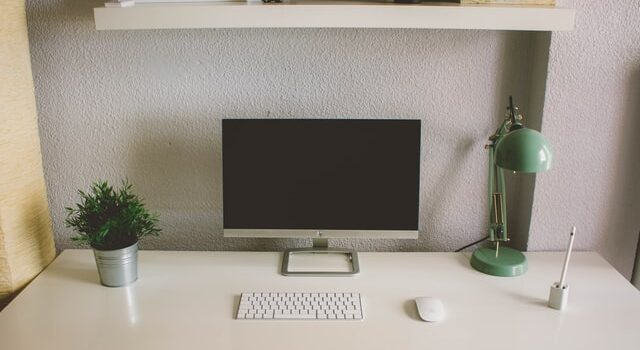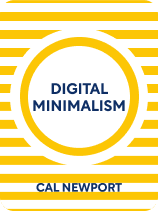

This article is an excerpt from the Shortform book guide to "Digital Minimalism" by Cal Newport. Shortform has the world's best summaries and analyses of books you should be reading.
Like this article? Sign up for a free trial here .
What is Cal Newport’s Digital Minimalism book about? What are some ways you can cut back on your use of digital communication technology without compromising your relationships?
In his book Digital Minimalism, Cal Newport applies the lifestyle concept of minimalism to the use of technology. Drawing on a wide range of real-life examples, Newport discusses the common practices of digital minimalists and distills the central principles that underpin them.
Here is a brief overview of Cal Newport’s book Digital Minimalism: Choosing a Focused Life in a Noisy World.
Digital Minimalism Book: Focused Life in a Noisy World
Many of us are glued to our smartphones, tablets, and laptops, slavishly checking Facebook updates, refreshing email, and scanning Twitter. Although most people adopted these technologies for their benefits, they’ve become so tethered to them that they’ve lost control of how they spend their time and attention. People feel overpowered and exhausted by the multitude of digital tools at their fingertips, including devices like smartphones and tablets, websites, addictive apps, and social media platforms. Meanwhile, tech companies continue to invest major resources into making their products and services addictive so that you’ll continue scrolling and tapping.
Cal Newport’s book Digital Minimalism explains how practicing digital minimalism can loosen technology’s grip on your attention. Digital minimalism aims to maximize the benefits of technology and avoid the pitfalls by identifying your values and using technology to support them.
Below is a quick summary of the main ideas discussed in Cal Newport’s book Digital Minimalism: Choosing a Focused Life in a Noisy World.
Principles of Digital Minimalism
A growing number of people are preaching the benefits of pulling back from the total technology immersion that has become the default for many. Those who promote reducing technology use typically advise simple hacks like turning off notifications. However, instead of hacks, most people need a complete overhaul—and that starts with developing a philosophy of technology use. Digital minimalism is one such philosophy, which requires that you identify what values and activities are priorities in your life, determine which digital tools promote those priorities, and implement constraints for using these tools to maximize their benefits and minimize their harm and distraction.
Let’s explore the three main principles of digital minimalism:
- Eliminate clutter. Digital minimalists assess technology with cost-benefit analyses, which involves asking yourself whether a technology adds value to your life beyond minor convenience, and whether the technology is the best way to support your values. In other words, Facebook may be an easy way to keep up with family and friends, but is it the best way? You may be better off calling or visiting them. If you assess every digital tool with these criteria, you’ll likely end up reducing or eliminating your need for these devices.
- Optimize your technology use. Once you’ve pared down your apps and devices, decide how to get the most benefits with the fewest distractions. Instead of looking at an app or device as a single tool, think about it as a collection of features, such as direct messaging and marketing platforms. With this view, you can optimize your digital use based purely on the tools they provide, and it’ll be easier to bypass the rest of the noise.
- Take control and feel empowered. One of the most harmful effects of technology addiction is that users feel that they don’t have control over their own time and attention. But you can avoid all of the issues that come with technology overuse if you can simply control your digital habits, and reclaiming that control is empowering.
Digital Declutter
The most effective way to adopt digital minimalism is to start with a digital declutter, which is a 30-day detox from all non-essential technology. The digital declutter allows time for you to break your addictive habits, engage with more meaningful activities, and get a clean slate from which you can set the parameters for your long-term digital use.
Let’s discuss the three steps to the declutter process:
- Outline the rules for your declutter. The digital declutter involves banning all optional technologies, so you must first define what is an optional technology. “Technology” includes websites, apps, and other digital tools that you access through your phone or computer. “Optional” technology is something that you can ignore for a month without causing harm to your personal or professional life. Be careful to distinguish between technologies that are essential and those that are merely convenient.
- Declutter for 30 days. Now that you’ve set the rules, the next step is to follow them for one month. At first, it will be hard to break your tech use habits, but those reflexes typically fade after a week or two. The declutter enables you to reset your habits and your mindset, so that your digital addictions don’t cloud your judgment and make certain technologies seem more essential than they are. After 30 days of declutter, when it’s time to reintroduce select technologies back into your life, you’ll be better able to make those decisions. Additionally, the digital declutter gives you time to reconnect with your interests and passions by revisiting old activities and trying new ones.
- Reintroduce select technology. After the 30 days, choose which technologies to reintroduce into your life, and decide how to use them. For each technology, ask yourself three questions: First, does the technology directly support a value that’s important to you? Second, does this technology offer the best way to support that value? Third, how will you use the technology so that you’re only using the feature that supports that value? Lay out the rules for when or how often you use the digital tool, how you use it, and how to minimize distractions.
Reclaiming Time for Yourself
When you start to realize all the time you could gain by changing your digital habits, you’ll want to start filling it with something else. But it’s important that you spend some of that time doing nothing. Because digital tools are ubiquitous and addictive, they have robbed us of invaluable solitude. This may seem like a small loss, but even brief moments of solitude are critical for your mental and emotional well-being.
It’s easy to overlook the value of solitude, because our culture places a high value on connectivity. While close personal relationships are a critical source of happiness, time with close friends and family must still be balanced with time spent alone with your thoughts. This means having a break from outside input from other people, TV, podcasts, and anything on your phone or computer. Solitude is essential in order to:
- Come up with new ideas. When you have the space to think, without any external input, you’ll be better able to work through difficult problems and come up with more creative ideas. This may also be why many writers and other famous figures have been prolific during periods of solitude.
- Develop a better understanding of yourself. Spending time alone with your thoughts gives you the opportunity for valuable self-reflection. As you get to know yourself better, you’ll become better at regulating your emotions.
- Support strong intimate relationships with others. Although this seems paradoxical, having time alone makes you more appreciative of the time you spend with others.
Digital tools today are more ubiquitous than any of their technological predecessors. Whereas previous technologies could interrupt solitude intermittently, the iPod and iPhone were the first innovations that could continuously distract people from their thoughts, even in brief moments and inconvenient locations. As a result, people now face the real threat of solitude deprivation, meaning that they have virtually no time with their own thoughts. Solitude deprivation impedes your ability to think creatively, deliberate on problems, get to know yourself, and foster strong relationships—in other words, it brings down your quality of life.
Reclaiming Your Relationships
Just as important as humans’ need for solitude is their need for meaningful social interaction. The human brain evolved to be extremely sophisticated in navigating social interactions because relationships have always been vital to humans’ health and survival. When you communicate with people face-to-face, on the phone, or over a video call—any means that’s not text-based—it stretches your mental muscles for social connection, such as reading body language, tone of voice, and facial expressions. However, digital communication has replaced much of people’s face-to-face and phone conversations, but texts, comments, and emails fail to feed people’s deep psychological social needs.
Rich, face-to-face communication draws on humans’ evolutionary social skills and is a meaningful experience because:
- It requires you to practice listening and interpreting nonverbal communication.
- It allows you to feel heard and understood.
- It helps you to develop empathy.
Despite the benefits of non-text interaction, people gravitate toward digital communication because—in addition to being wired for social connection—humans evolved to seek out the most efficient ways of doing things, despite the trade-offs. This leads to behaviors such as compulsively checking your phone even while carrying on a conversation with the person sitting in front of you, spending all your time on digital devices and leaving none for richer forms of interaction, and mistakenly assuming that digital communication is a substitute for face-to-face conversation. But, when you replace most of your conversations with digital, text-based communication, you eventually lose your social skills and become unable to satisfy your deep-seated social needs. For example, some adolescents have a hard time being empathetic because they haven’t had enough practice reading facial expressions to interpret what other people are feeling.
In order to maintain your communication skills and fulfill your social needs, you must not only incorporate more conversation into your life, but also change the way you use digital communication tools. Merely supplementing your digital connections with real-life conversations won’t create the fundamental shift you need for significant, sustained changes—rather, harness digital tools and use them to promote meaningful interactions, rather than replace them.
To shift the balance between your connections and your conversations, use digital (text-based) communication for only two purposes:
- Planning and coordinating conversations
- Sharing simple logistical information
When you adopt these practices, the number of people you actively communicate with will almost certainly shrink, because you won’t have enough time to keep up meaningful communication with everyone you follow on social media. You might initially feel lonely as you watch your social circle appear to shrink, but you’ll soon notice that the relationships that survive this shift will become stronger. Instead of maintaining constant connection with a large network of weak ties and acquaintances, you’ll enjoy meaningful communication with a smaller group of close friends.
Reclaiming Your Leisure Time
In order to successfully reduce your digital habits, you need to first identify the meaningful leisure activities that will take their place. While scrolling and tapping on your devices may feel like a pleasant way to decompress, they are low-quality leisure activities—they don’t contribute much value to your life and they don’t energize you. When you cut down on your digital use and deliberately fill that time with meaningful activities, the high-quality leisure will leave you feeling more energized and fulfilled than your digital habits.
As you think of the ways you could fill your newfound free time, consider the following three lessons about what defines high-quality leisure activities.
- Demanding activities are more rewarding than passive ones. Dedicating your leisure time to demanding activities actually energizes you more than idly passing the time. When you learn a new skill or finish a task, it leaves you feeling uniquely proud and accomplished. The more energy you invest in your leisure, the more value you’ll gain.
- Humans get satisfaction and self-worth from making things with their hands. High-quality leisure includes craft—which entails using a skill to practice or create something. In other words, by this definition, crafts encompass building a DIY headboard as well as practicing a song on the guitar.
- In-person, structured social activities are rejuvenating. Certain leisure activities—like competitive games and sports—create an environment for supercharged socializing, where the people involved can interact more intensely than they would in normal conversations. For example, it would be inappropriate to yell encouraging words and chest bump at a cocktail party, but these displays are encouraged in a kickball game with friends. Supercharged socializing is an energizing and rewarding way to spend your leisure time.
In the spirit of digital minimalism, there is a growing movement of people using technology to support leisure activities instead of relying on technology to be the activity. First, you can go online to find communities of people who share your interests so that you can connect with them in person. Second, if you’re picking up a new skill or hobby, you can find detailed instructions, how-to videos, and sources for obscure materials and tools.
Reclaiming Your Attention
Since tech companies have a vested interest in keeping you addicted to your devices, reclaiming control of your attention requires strong conviction and thorough planning. The key to digital minimalism is to change how you view and use technology so that you use only the tools that benefit you, and forego the rest of the distractions. Here are some strategies to help you achieve this:
- Delete your social media apps. These apps are designed to be more addictive than the web versions, and they’re always with you when they’re on your smartphone, making it almost impossible to resist checking them when you have a few free moments. If you have to log onto a computer to access those platforms, it will naturally limit how often you use them, and you’ll be more selective about when and why you log on.
- Limit your smartphone’s capabilities. Block all distracting apps, websites, and functions on your digital devices, ideally by default or on a set schedule—for example, during work hours—and then unblock certain services when you need them. There are several digital tools that help you to create these blocks, such as Freedom and SelfControl. The goal is to turn your smartphone, tablet, or computer into a single-purpose device as much as possible.
- Use social media strategically. When it comes to being intentional about digital use, take a cue from social media professionals—they have to be smart about avoiding distractions, or they’d get nothing done. Consider strategies such as keeping a short friend list on Facebook, following a small number of accounts on Instagram and Twitter, and creating separate Twitter accounts for professional needs and personal interests.
- Transition to “slow media.” The Slow Media movement encourages people to shift their media consumption to high-quality sources over convenient, low-quality media. For example, if you used this approach for your news consumption, you would forego checking various social media and news sites throughout the day, and instead check a reliable source once or twice a day. You might also save longer articles that you come across throughout the week and spend a quiet Saturday morning reading them with a cup of coffee.
- Get a “dumb” phone. Trading your smartphone for a cell phone that can only make calls and send texts is the most effective action you can take in resisting tech addiction and overuse. As tablets and laptops become lighter and more portable, you can rely on those devices for internet access. Alternatively, if you need your smartphone for work or other logistical reasons, you can get a tethered dumb phone: When you want to have some time without your smartphone, activate your tethered phone to have texts and phone calls forwarded from your smartphone.
Digital minimalists aren’t anti-technology—rather, they want to be intentional about how they use technology in order to maximize its benefits. Digital minimalists are content to miss out on low-value digital experiences because they’ve chosen to invest only in high-value experiences, in both the virtual and real worlds. If you decide to adopt this philosophy, you have to put in time and effort, and you’ll probably falter along the way, but you’ll be on the path to a higher quality of life.

———End of Preview———
Like what you just read? Read the rest of the world's best book summary and analysis of Cal Newport's "Digital Minimalism" at Shortform .
Here's what you'll find in our full Digital Minimalism summary :
- Why you're addicted to technology (and how tech companies feed your addictions)
- How a focus on social media is bad for real-life relationships
- How to transform your tech habits to get the best benefits without the drawbacks






